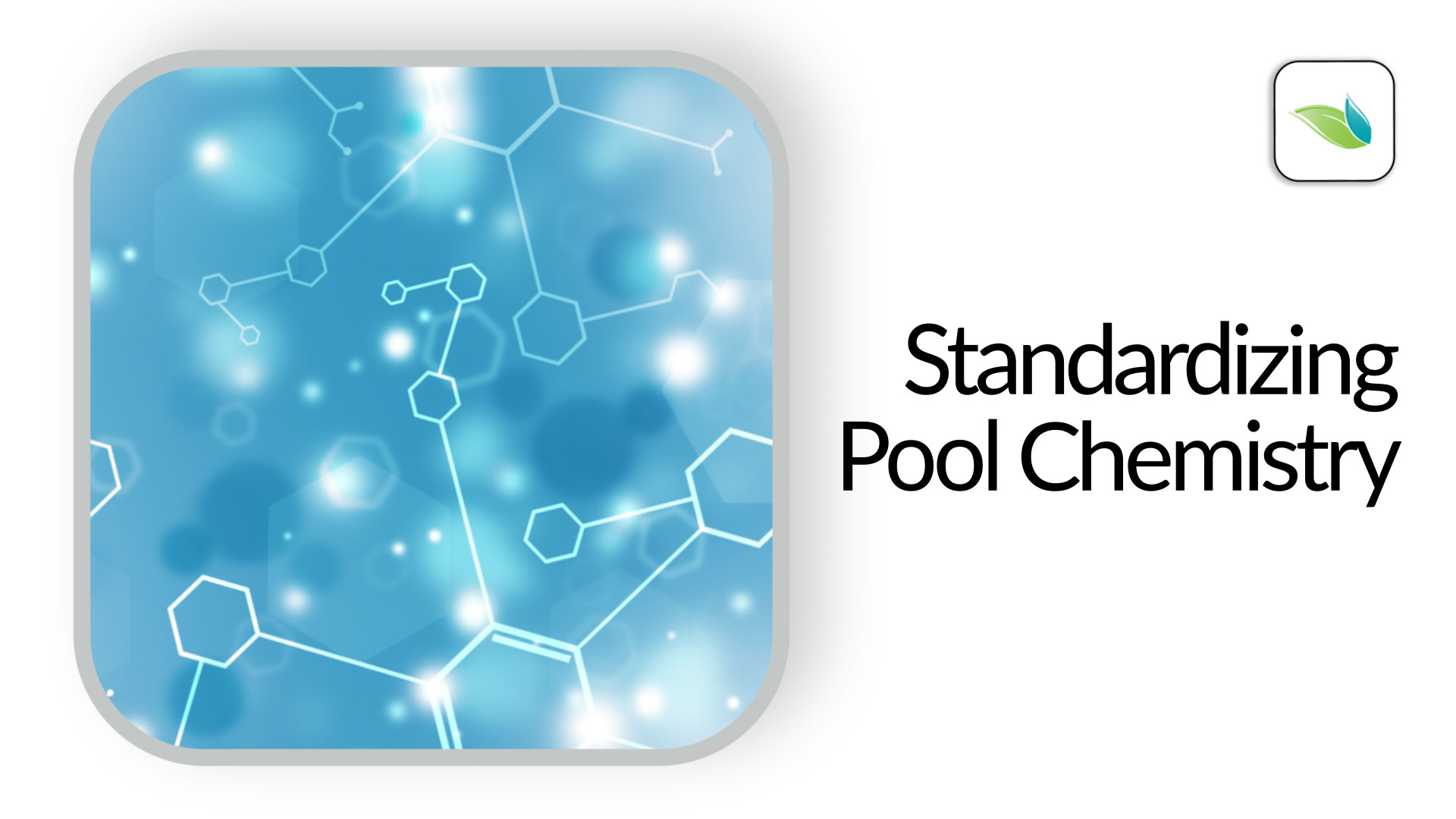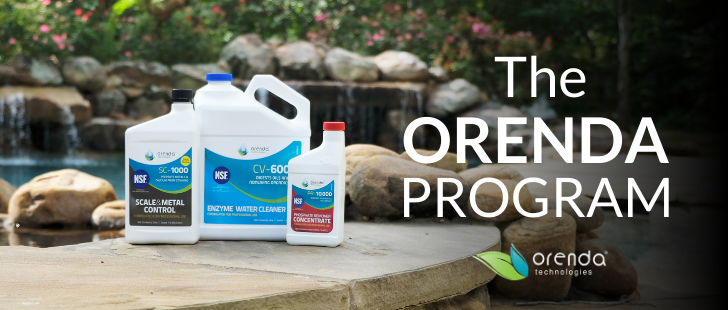Standardizing Pool Chemistry

We have recently noticed that most swimming pool service companies we speak to do not have a well-defined, standardized operating procedure (SOP) for water chemistry. Regardless of the number of pools the company services, we believe all service companies can benefit from standardizing a few things. This article will explain why.
Covered in this article
- What is a Standard Operating Procedure (SOP)?
- The Orenda Program
- First, you must decide
- A baseline for all your pools
- Step 1: Get CYA under control
- Step 2: Establish calcium hardness and total alkalinity levels
- Step 3: Clearly define your SOP for all employees to follow
- Step 4: Purge and remove contaminants
- Step 5: Track it
- Reasons to standardize pool water chemistry across a pool service business
- Your brand will benefit
- Personnel substitutions are easier
- Problems will stand out, and sooner
- Collective intelligence and team learning
- Reduced employee turnover
- Better financial forecasting
- Bulk purchasing discounts
- Conclusion
What is a Standard Operating Procedure (SOP)?
A standard operating procedure (SOP) is a clearly defined set of instructions, rules, or guidelines for a given scenario. They are most commonly used in the military, but SOPs are also common in large companies and other organizations.
It's something like "If/when X happens, do Y. If Y doesn't work, your next step is Z."
Pool companies around the country share many of the same challenges and concerns: it’s hard to find employees–let alone good employees–and it’s hard to keep them engaged. Prices on everything are rising faster than pool service rates can be raised. Chlorine and acid are in short supply and behaviors are being forced to change. Old school practices are becoming impractical, if not impossible.
Sound familiar?
Our industry has been reactionary for so long, we don’t realize how much money and energy we have been wasting. Reactive pool care is stressful, whereas proactive pool care is empowering. And by standardizing certain water chemistry parameters across all the pools in your business, things become much more simple. So let's talk about how you can implement your own SOP in your pool business that allows for your entire company to be proactive and less complex.
The Orenda Program
First, you must decide
The word “decide” originates from Latin. The prefix “De-” means off, or from, as in separating from. The suffix “-cide” should sound familiar: pesticide, algaecide, homicide, genocide, etc.. It means to kill, or cut down. Therefore, "decide" means to cut off, or to kill off. More specifically, it means you cut off all other options and commit to one.
In its original meaning, when we decide, we are not simply picking one option for now, and keeping other options open. No. When we truly decide, we must eliminate all other options from the equation.
Therefore, when you decide to implement a proactive SOP to your business–like The Orenda Program–you are making a commitment to eliminate unwanted things from the water. You decide to standardize pool chemistry across the board (with few exceptions, as needed), and you decide to address bad habits. That's how to have the cleanest, purest pool water–simplify and decide to eliminate factors you don't want.
We created our Four Pillars curriculum because we found that almost all pool chemistry problems we encounter boil down to those four common denominators. So in the Orenda SOP, we decide to…
- Manage the Langelier Saturation Index (LSI) to keep the water balanced and prevent etching and scale formation (Pillar 1). We prioritize LSI over range chemistry.
- Contain pH instead of trying to control it, thus reducing the risk of a pH rebound and/or LSI violations.
- Chelate metals and minerals so our chlorine does not get used up oxidizing metals, and minerals like calcium do not form scale.
- Remove non-living organics and oils from the water, which account for over 90% of chlorine demand (Pillar 2).
- Remove phosphates from the water to optimize chlorine efficiency (Pillar 3).
- Minimize cyanuric acid (CYA) to remove the risk of overstabilization and improve chlorine’s killing speed (Pillar 4).
- Not use products that leave behind long-term byproducts, like algaecides.
- Not use chemicals that conflict with one another.
Related: How to Implement the Orenda Program
A baseline for all your pools
You can start standardizing and simplifying your pool business by creating a baseline of LSI-focused chemistry targets across all of your pools. Textbook range chemistry is usually insufficient. In fact, in most areas of the country, those ranges are likely to cause problems at some point throughout the year. Focus instead on the LSI, and maintaining LSI balance year-round (Pillar 1).
Let's walk you through how we would go about making these changes...
Step 1: Get CYA under control
We recommend starting with cyanuric acid (CYA). If you have too much CYA, dilute that number down to 50 ppm or less before you begin adding calcium and modifying the rest of your pool chemistry. It’s not practical to spend money on adding calcium just to dilute it the next week. So start there.
Step 2: Establish calcium hardness and total alkalinity levels
The next two factors are calcium hardness (CH) and total alkalinity (TA). These can be modified at the same time following our procedure on how to add calcium. Your CH level will depend on where you live because this parameter is mostly driven by water temperature. TA, however, depends more on your primary sanitizer. Acidic chlorine (like trichlor) would need more alkalinity–like 80-100 ppm.1 Most chlorines–cal hypo, liquid, and salt chlorine generators–should have about 60-70 TA when the water is over 70ºF. This reduced TA lowers the pH ceiling, limiting how high the pH can naturally rise.
Step 3: Clearly define your SOP for all employees to follow
This is where great companies separate themselves from the good, mediocre, and struggling companies. Great pool companies have taken the time to clearly define–and write down–their standard operating procedure (SOP). But even great companies often do not have a clearly defined baseline for CYA, CH, and TA, as discussed above.
This step is less about chemistry targets and more about defining the behavior expected of employees. Specifically, we're talking about using measuring cups, always diluting acid, using a thermometer, and avoiding the rest of the top six bad habits in the pool industry. We have a few podcast episodes devoted to these best practices and mistakes to avoid. Your employees can listen for free while they drive and work.
The point is to have a clearly defined set of expectations.
Step 4: Purge and remove contaminants
Swimming pools tend to get overwhelmed with oxidants, which increase chlorine consumption. And we're living in a time of chlorine shortages. One thing that helps get your pools off to a great start in the spring is purging with CV-600 or CV-700 enzymes to remove the non-living organics on oils throughout the pool system. Not just the water, but in the filter, 90º elbows in the plumbing, and other places you cannot see. We think of it kind of like a deep herbal cleanse at the beginning of the swim season.
Related: What is the Orenda "purge" and why is it necessary?
You can also remove phosphates with PR-10,000 to get below 500 ppb. If you have stain or scale concerns, you can chelate metals and minerals with SC-1000 in the springtime too. Get those metals and minerals bound up and spoken for the summer.
Addressing these issues up-front gives you a baseline too. That is, if you decide to remove such contaminants from your pools. Chlorine alone cannot handle these things.
Step 5: Track it
All of these recommendations are measurable in one way or another. Steps 1 and 2 are easily measured with your test kit. Log those in your Pool Service Software (PSS), spreadsheet, or logbook. Whatever you use to keep track of your water chemistry. You will soon find that once all of your pools have a baseline of CYA, CH, and TA, any deviations will stand out. Whereas before, when everyone was 'doing their own thing', there was no way to measure what was going on in the field.
Reasons to standardize pool water chemistry across a pool service business
These are some of the reasons we can think of right now, and this list is likely to grow...
Your brand will benefit
It should go without saying that a company with a uniform brand appearance has advantages over companies that do not. Branding is about establishing expectations about who you are, what you do, and the quality of your product and service. Sure, there are always exceptions to the rule, but in general, your brand says a lot about your company.
Obvious branding elements are uniforms/clothing, vehicles, and marketing materials. The water quality and clarity in the pools you service are your 'deliverable' to the customer. How the water looks and feels is tangible evidence of whether or not you're delivering a good enough service. Standardizing water quality reflects positively on your brand. If you deliver excellent water for one customer, it's reasonable to assume you deliver the same for other customers too. Never underestimate the power of customer referrals.
Personnel substitutions are easier
What happens when one of your people gets sick (or worse–quits)? Do you and the rest of the company know how they have been treating the water? What if they've been 'doing their own thing' for years? Substitutions like this are common, and responsible companies know they should test all the water before treating it–even if that rarely happens, it's the best practice.
We get calls from pool companies who are stunned to learn how different each service tech treats their pools. But if all the pools–with few exceptions2–had the same baseline chemistry, personnel substitutions become easy. You won't need to wonder what the CYA or calcium hardness level is, and making a pH correction that sticks within your chemistry strategy is not complicated.
Problems will stand out, and sooner
If all your pools have approximately the same CYA, calcium hardness, and total alkalinity, that's a really good start. Everyone should be using approximately the same amount of acid each week (and it's less than you might think). Everyone should be experiencing similar dilution rates for CYA and calcium hardness too. You get the idea.
When a service tech starts deviating from the average of the company, that's not a bad thing, it's a great thing! There's something different on that route, and you can identify it early. What's different? Which pool? Maybe you can have that route supervised to spot irregularities or issues as early as possible. Let's use the example of one service technician using 40% more acid each week than everyone else. Such a deviation from the norm should jump out at you when you are reviewing your numbers each week.
Without a baseline, these differences are much more difficult–if not impossible–to recognize. Until it's too late. Most pool problems are totally preventable, and standardizing your route allows for early detection and treatment before the problem grows into something major.
Collective intelligence and team learning

Speaking of identifying problems early, one major advantage of standardizing water chemistry is collective intelligence. An individual service pro–even if they've been doing it for decades–mainly learns from their own experience. Standardizing allows teammates to also learn from everyone else's experiences.
Let's get back to the previous example of that one service tech who is consuming way more acid than the company average. Hone in on that tech and identify the issue. Maybe it's a bad habit or forgetting a practice. Or maybe they just happen to have a complex route. Or the neighborhood they service is all on well water with very high alkalinity. And this is not limited to just acid...it could be chlorine and other additives too.
Whatever the issue is, everyone benefits from learning about it. The company benefits. It's no longer just correcting behavior and potentially embarrassing the technician; it's about everyone learning from one. 5 people have 5-times more experience in a given week than any one person. You might be surprised how many other people face the same challenges. Create a team culture that incentivizes them to speak up! It helps everyone learn faster, and it helps prevent major problems.
When the route is standardized, people have less incentive to cover up their mistakes. In fact, it's the opposite...they should be incentivized to open up and share their issues so the team can work together to fix them and learn. And that brings us to employee retention.
Reduced employee turnover
We recently visited and trained a pool service company that had converted their entire business into following the Orenda Program. This includes standardizing their CYA, calcium, and alkalinity, as well as using our products throughout the season. When we asked the business owner why he made the commitment to changing his business model so drastically, his answer surprised us: for him, the Orenda Program reduces employee turnover.
We live in a time where employee turnover and labor shortages are two of the biggest problems in the entire economy. In all industries, but especially services and labor.
With new employees especially, there is a lot of pressure on a pool service technician. The water is exposed to contaminants 24/7, yet most can only visit the pool once a week to clean it. They need to understand hydraulics, plumbing, electrical, and chemistry. When a pool starts facing issues like cloudy water, scale formation, plaster discoloration, or algae, it's stressful. Does the employee speak up and potentially get in trouble, or feel embarrassed for not knowing how to fix it? Do they have to defend themselves when an upset homeowner questions their ability?
Standardizing pool chemistry increases the margin for error, which buys a new employee time to learn on the job. Combined with the Orenda Program (in the case of the company just mentioned), employees get some early wins. Their water looks and feels great. They get some compliments from homeowners, and those compliments go a long way.
Better financial forecasting
Do you know how much each of your service technicians uses on a weekly basis? How much chlorine, acid, bicarb, and specialty chemicals? Do you know if their chemical consumption is appropriate? Is it consistent and predictable?
Most companies we talk to have never looked at their numbers in this way. How are you supposed to forecast the chemicals you will need if everyone in your company is doing their own thing? We live in a time of product shortages and supply chain woes. Forecasting is critical to running a profitable business. If everyone is following the same baseline chemistry, forecasting is much easier.
Bulk-purchasing discounts
A pool company with the same baseline chemistry leads to better forecasting, which opens yet another opportunity to improve profitability: bulk-purchasing discounts. When everyone's doing the same thing, you're buying a lot of the same products, and less urgent products on the fly.
Conclusion
If you work for, manage, or own a pool service business, we hope this resonates with you. You are not alone. In summary, when people do their own thing without a consistent baseline, predictability and profitability are much more difficult. Start with CYA, calcium, and total alkalinity. Then decide if you want to deal with non-living organics, phosphates, and metals. If you decide not to, address them accordingly (we can help).
When you do these things, enjoy how much simpler pool care can be.
If you want Orenda training for you and your company, you can request virtual training in both English and Spanish. Prior to that, however, start with our free online Orenda Academy™ programs. These resources are available to you–free of charge–to help you and your team learn and grow.
1 That being said, in the Orenda SOP, trichlor is not recommended as your primary chlorine. It can be okay as a supplement to non-stabilized chlorine, but when trichlor is your primary chlorine, CYA overstabilization is virtually guaranteed.
2 Exceptions may include pools with a solid automatic cover that stays closed most of the time, heated indoor pools, pools without CYA, and pools that use non-chlorine sanitizers.

